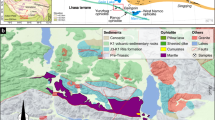Abstract
The Quaternary White Trachytic Tuffs Formation from Roccamonfina Volcano (southern Italy) comprises four non-welded, trachytic, pyroclastic sequences bounded by paleosols, each of which corresponds to small- to intermediate-volume explosive eruptions from central vents. From oldest to youngest they are: White Trachytic Tuff (WTT) Cupa, WTT Aulpi, WTT S. Clemente, and WTT Galluccio. The WTT Galluccio eruption was the largest and emplaced ∼ 4 km3 of magma. The internal stratigraphy of all four WTT eruptive units is a complex association of fallout, surge, and pyroclastic flow deposits. Each eruptive unit is organized into two facies associations, Facies Association A below Facies Association B. The emplacement of the two facies associations may have been separated by short time breaks allowing for limited reworking and erosion. Facies Association A consists of interbedded fallout deposits, surge deposits, and subordinate ignimbrites. This facies association involved the eruption of the most evolved trachytic magma, and pumice clasts are white and well vesiculated. The grain size coarsens upward in Facies Association A, with upward increases of dune bedform wavelengths and a decrease in the proportion of fine ash. These trends could reflect an increase in eruption column height from the onset of the eruption and possibly also in mass eruption rate. Facies Association B comprises massive ignimbrites that are progressively richer in lithic clast content. This association involved the eruption of more mafic magma, and pumice clasts are gray and poorly vesiculated. Facies Association B is interpreted to record the climax of the eruption. Phreatomagmatic deposits occur at different stratigraphic levels in the four WTT and have different facies characteristics. The deposits reflect the style and degree of magma–water interaction and the local hydrogeology. Very fine-grained, lithic-poor phreatomagmatic surge deposits found at the base of WTT Cupa and WTT Galluccio could record the interaction of the erupting magma with a lake that occupied the Roccamonfina summit depression. Renewed magma–water interaction later in the WTT Galluccio eruption is indicated by fine grained, lithic-bearing phreatomagmatic fall and surge deposits occurring at the top of Facies Association A. They could be interpreted to reflect shifts of the magma fragmentation level to highly transmissive, regional aquifers located beneath the Roccamonfina edifice, possibly heralding a caldera collapse event.
Similar content being viewed by others
Author information
Authors and Affiliations
Additional information
Received: 26 August 1996 / Accepted: 27 February 1998
Rights and permissions
About this article
Cite this article
Giordano, G. Facies characteristics and magma–water interaction of the White Trachytic Tuffs (Roccamonfina Volcano, southern Italy). Bull Volcanol 60, 10–26 (1998). https://doi.org/10.1007/s004450050213
Issue Date:
DOI: https://doi.org/10.1007/s004450050213




